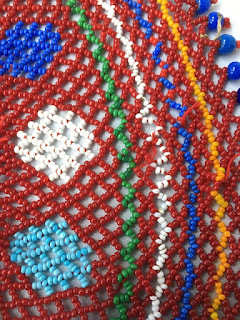 |
| Eva's 'kryvulka' returned |
My Canada Day 2020 visit to deliver a restored 'kryvulka' to Orysia Sopinka yielded unexpected riches.
To this point, all I had seen was the broad collar 'kryvulka' beaded by Orysia's mother, Eva Vakyriak, an ethnic Lemko from Chystohorb, an administrative centre of Komancha, within Sanok County, in the Subcarpathian Voivodeship of south-eastern Poland, close to the border of Slovakia.
 |
| Eva Vakyriak (1920-2014) |
As was the custom, girls would bead, embroider and sew their own folk costumes for festive occasions. In keeping with tradition, young Eva created her very own ensemble comprised of all essential elements of a Lemko-style costume. We know she would have started her accoutrements as a teen because in 1939 she was off to work in Germany as an Osterbeiter, a slave worker.
 |
| Orysia displaying Eva's 'lajbychok' |
Orysia pulled out a 'lajbychok' (vest) her mother beaded. She kept referring to this fabric work of art in the diminutive form. You could sense the endearment. The more I looked at the 'lajbek' style common in this area, I saw Eva's 'lajbychok' was more refined and one-of-a-kind.
 |
| back of 'lajbychok' |
Her 'lajbychok' was made of navy fabric with a jacquard weave. This would have been been an expensive purchase, but justifiably worth it! The vest was lined with a loomwoven natural fabric. Great care was taken to cut out the fitted vest and individual tabs which were lined in navy.
 |
| detail of lower back beadwork |
Using a wide palette of seed beads and bugles, Eva bead embroidered a large floral composition on the lower back. It's sitting on a yellow-outlined ground. The floral bouquet is framed with an arch of star bursts and delicate daisies. I recognized some of the seed beads as spares from her 'kryvulka'. While the arch around her floral composition is fanciful, the floral bead embroidery of every tab is symmetrical and identical. The tabs were perfectly overlapped all around the base of the vest.
 |
| beadwork around armhole |
Very delicate beaded daisies and bugle V's were embroidered around the armhole opening, neck edge and down the front.
Smaller florals mirror each other on the 'lajbychok' front. They are sitting on a green-outlined ground.
Check out the floral buttons!! They're probably from Czechoslovakia where pressed-glass buttons are a specialty.
The inside of the 'lajbychok' reveals Eva used a natural thread to bead embroider through the navy and lining fabric. There was no extra satin lining to cover the stitches.
Then, Orysia brought out her mother 'spidnytsia' (skirt). She first showed the front which was flat with a plain fabric insert. Really, this was a practical solution to keep down the bulk as a decorative 'fartukh' (apron) would have been worn overtop in front.
The skirt was a red printed fabric base which has rows of lace, blue and yellow ribbon stitched down on either side of a natural band. Great care was taken to use the red fabric as part of the striped design. Once the bands were stitched, the red fabric was densely pleated with fine tucks hidden up inside a wide natural fabric band. This made for a very full 'spidnytsia' on the sides and back. A little strip of a similar printed fabric was used to bind the edge of 'kryvulka' so it could be comfortably worn as a collar with the ensemble. (See Lemko 'kryvulka' restoration post)
The 'spidnytsia' hem was finished in a narrow printed navy fabric. It must have been machine stitched on front and fold down and around to the underside. Perfect hand stitches secure the roll-like binding in place.
In these three main elements you can see the harmony of red 'kryvulka', navy bead embroidered 'lajbychok' and the red 'spidnytsia' with ribbon trim. These elements are part of the Lemko-style costume, but Eva creatively embellished each one her way.
Being able to see such beauty up close made for a truly a memorable Canada Day!
As I was preparing my blog, I wanted a photo of Eva (seen above). I started to question how did Orysia come into possession of these original pieces her mother made, if she left in a hurry to work in Germany?
 |
| Maria Sopinka wearing a 'sylianka' |
Orysia also brought this photo of her aunt wearing a beadwoven band with motifs which was fashionable in the 20th century.
Orysia writes: "Maria Sopinka was born in Vyslik Velykij probably in the 1920's. My father, Teodor Sopinka was her half brother. He was the youngest child, born in 1917, from the first wife and Maria was born to the second wife. Vyslik Velykij was the largest town in Lemkivshchyna with a population of about 2,000 people. Both mama's and tato's families were Lemky and strong partisans for an independent Ukraine. Tato's family ended up in Bila Krynytsya near Pidhajtsi, Ukraine and Maria escaped through the forest and crossed the border to Slovakia."
I am grateful to Orysia for allowing me to share this story of a very patriotic Lemko family whom I got to know about through my interest in all things beaded and folk art.

































